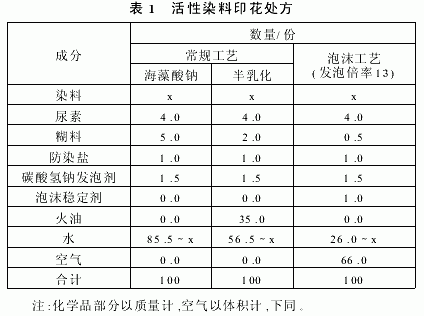When formulating foam processing prescriptions, reference can be made to parameters such as foaming efficiency, foam stability, drainage rate, foaming agent and foam stabilizer compatibility with dyes and other textile auxiliaries. The foaming process is predicated on removing the required moisture from conventional processing recipes, adding the selected foaming agent and foam stabilizer, and blending the air required for the specified foaming ratio. When compared to a conventional formulation containing 10 parts solids and 90 parts water, when the foaming ratio is 1:2, the foam formulation contains 10 parts solids, 40 parts water and 50 parts air. It can be seen that the foam prescription can save 55.5% of water and corresponding energy consumption instead of conventional prescriptions. Typical foam-printing prescriptions for reactive dyes, disperse dyes, and coatings (foaming magnification 13) are compared with conventional prescriptions, as shown in the table.

Formulation of foaming liquid in foam printing process
It is known from the table that a large amount of water in the foam process prescription is replaced by air, and no fire oil is used at all. In addition, the amount of paste in active and disperse dye printing pastes is also greatly reduced.
Source: Global Textile Network
Ceramic Straightener There are several types of ceramic straighteners available, and this iron is one of the best I`ve seen. It helps infuse the hair with volume and body, and has even heat distribution to get it pin straight with minimal damage.
ceramic heat gets hair straight in a snap, and with 30 temperature dial heat settings, you can adjust to best fit the thickness and texture of your hair.
Ceramic Straightener,Hair Smoothing Treatment,Ceramic Hair Straightener,Hair Straightener Online
Ningbo Meirou Electric Appliance Co.,Ltd. , https://www.mrhairstraightener.com